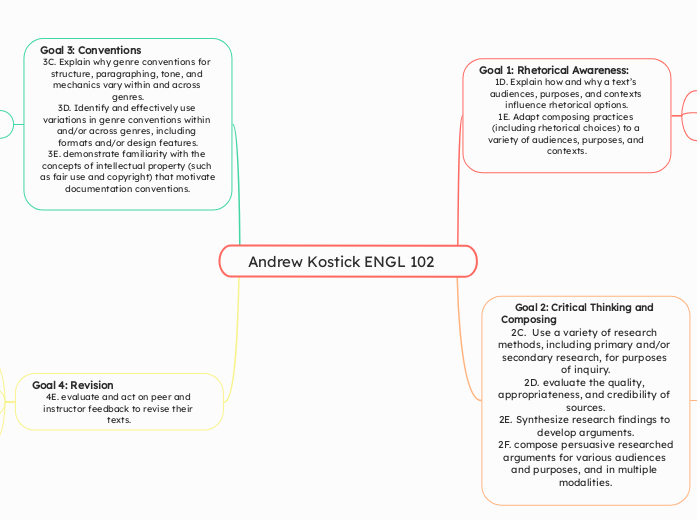Andrew Kostick ENGL 102
Goal 1: Rhetorical Awareness: 1D. Explain how and why a text’s audiences, purposes, and contexts influence rhetorical options.
1E. Adapt composing practices (including rhetorical choices) to a variety of audiences, purposes, and contexts.
DD4HW3: Examine Sample Annotated Bibliographies
DD12HW3: Annotate & Analyze Audience & Author
DD11HW2: Submit Final, Polished Version of P1 Annotated Bibliography
Goal 2: Critical Thinking and Composing 2C. Use a variety of research methods, including primary and/or secondary research, for purposes of inquiry.
2D. evaluate the quality, appropriateness, and credibility of sources.
2E. Synthesize research findings to develop arguments.
2F. compose persuasive researched arguments for various audiences and purposes, and in multiple modalities.
DD3HW2: Conduct Initial Secondary Research
DD4HW1: Conduct Secondary Research
DD5HW1: Evaluate Sources
DD14HW1: Synthesize Your Data
Goal 3: Conventions 3C. Explain why genre conventions for structure, paragraphing, tone, and mechanics vary within and across genres.
3D. Identify and effectively use variations in genre conventions within and/or across genres, including formats and/or design features.
3E. demonstrate familiarity with the concepts of intellectual property (such as fair use and copyright) that motivate documentation conventions.
DD18HW2: Analyze Sample Portfolios
DD12HW1: What is a Comparative Rhetorical Analysis?
Goal 4: Revision 4E. evaluate and act on peer and instructor feedback to revise their texts.
DD15HW1: Peer Review of Complete Draft of Project #2
DD15HW2: First Draft of Project #2 for Instructor Feedback
DD9HW3: First Draft of Project #1 for Instructor Feedback
DD9HW2: Peer Review of First Full Draft of Project #1
